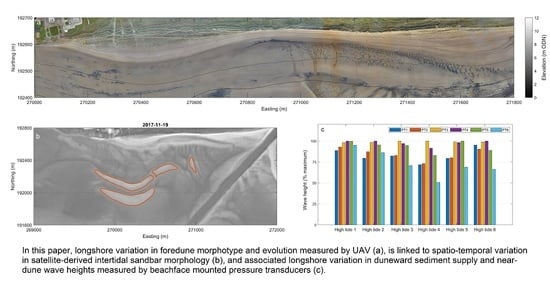Spatial Variation in Coastal Dune Evolution in a High Tidal Range Environment
Abstract
1. Introduction
2. Materials and Methods
2.1. Study Site
2.2. Survey Methodology
2.3. Satellite Derived Intertidal Bar Locations
2.4. Short Term Experiments on Wave Conditions Close to the Dune Line
3. Results
3.1. Morphological Surveys
3.2. Sattelite Derived Intertidal Bar Migration
3.3. Short Term Wave Experiments
4. Discussion
5. Conclusions
Author Contributions
Funding
Acknowledgments
Conflicts of Interest
References
- Drius, M.; Jones, L.; Marzialetti, F.; de Francesco, M.C.; Stanisci, A.; Carranza, M.L. Not just a sandy beach. The multi-service value of Mediterranean coastal dunes. Sci. Total Environ. 2019, 668, 1139–1155. [Google Scholar] [CrossRef] [PubMed]
- Sigren, J.M.; Figlus, J.; Highfield, W.; Feagin, R.A.; Armitage, A.R. The Effects of Coastal Dune Volume and Vegetation on Storm-Induced Property Damage: Analysis from Hurricane Ike. J. Coast. Res. 2018, 34, 164–173. [Google Scholar] [CrossRef]
- Gao, J.J.; Kennedy, D.M.; Konlechner, T.M. Coastal dune mobility over the past century: A global review. Progress Phys. Geogr. -Earth Environ. 2020. [Google Scholar] [CrossRef]
- Jackson, D.W.T.; Costas, S.; González-Villanueva, R.; Cooper, A. A global ‘greening’ of coastal dunes: An integrated consequence of climate change? Glob. Planet. Chang. 2019, 182, 103026. [Google Scholar] [CrossRef]
- Creer, J.; Litt, E.; Ratcliffe, J.; Rees, S.; Thomas, N.; Smith, P. A comment on some of the conclusions made by Delgado-Fernandez et al. (2019). “Is ‘re-mobilisation’ nature conservation or nature destruction? A commentary”. J. Coast. Conserv. 2020, 24, 29. [Google Scholar] [CrossRef]
- Delgado-Fernandez, I.; Davidson-Arnott, R.G.D.; Hesp, P.A. Is ‘re-mobilisation’ nature restoration or nature destruction? A commentary. J. Coast. Conserv. 2019, 23, 1093–1103. [Google Scholar] [CrossRef]
- Castelle, B.; Laporte-Fauret, Q.; Marieu, V.; Michalet, R.; Rosebery, D.; Bujan, S.; Lubac, B.; Bernard, J.B.; Valance, A.; Dupont, P.; et al. Nature-Based Solution along High-Energy Eroding Sandy Coasts: Preliminary Tests on the Reinstatement of Natural Dynamics in Reprofiled Coastal Dunes. Water 2019, 11, 2518. [Google Scholar] [CrossRef]
- Ruessink, B.G.; Arens, S.M.; Kuipers, M.; Donker, J.J.A. Coastal dune dynamics in response to excavated foredune notches. Aeolian Res. 2018, 31, 3–17. [Google Scholar] [CrossRef]
- Anthony, E.J.; Vanhee, S.; Ruz, M.H. Short-term beach-dune sand budgets on the north sea coast of France: Sand supply from shoreface to dunes, and the role of wind and fetch. Geomorphology 2006, 81, 316–329. [Google Scholar] [CrossRef]
- Bauer, B.O.; Davidson-Arnott, R.G.D. A general framework for modeling sediment supply to coastal dunes including wind angle, beach geometry, and fetch effects. Geomorphology 2003, 49, 89–108. [Google Scholar] [CrossRef]
- Jackson, D.W.T.; Beyers, M.; Delgado-Fernandez, I.; Baas, A.C.W.; Cooper, A.J.; Lynch, K. Airflow reversal and alternating corkscrew vortices in foredune wake zones during perpendicular and oblique offshore winds. Geomorphology 2013, 187, 86–93. [Google Scholar] [CrossRef]
- Hesp, P.A.; Smyth, T.A.G. Surfzone-Beach-Dune interactions: Flow and Sediment Transport across the Intertidal Beach and Backshore. J. Coast. Res. 2016, 8–12. [Google Scholar] [CrossRef]
- Nordstrom, K.F.; Jackson, N.L. Offshore aeolian sediment transport across a human-modified foredune. Earth Surf. Process. Landf. 2018, 43, 195–201. [Google Scholar] [CrossRef]
- Nordstrom, K.F.; Bauer, B.O.; Davidson-Arnott, R.G.D.; Gares, P.A.; Carter, R.W.G.; Jackson, D.W.T.; Sherman, D.J. Offshore Aeolian Transport Across a Beach: Carrick Finn Strand, Ireland. J. Coast. Res. 1996, 12, 664–672. [Google Scholar]
- Montreuil, A.L.; Bullard, J.E. Aeolian dune development on a macro-tidal coast with a complex wind regime, Lincolnshire coast, UK. J. Coast. Res. 2011, 64, 269–272. [Google Scholar]
- Nordstrom, K.F.; Gamper, U.; Fontolan, G.; Bezzi, A.; Jackson, N.L. Characteristics of Coastal Dune Topography and Vegetation in Environments Recently Modified Using Beach Fill and Vegetation Plantings, Veneto, Italy. Environ. Manag. 2009, 44, 1121–1135. [Google Scholar] [CrossRef]
- Jackson, N.L.; Nordstrom, K.F. Aeolian sediment transport and landforms in managed coastal systems: A review. Aeolian Res. 2011, 3, 181–196. [Google Scholar] [CrossRef]
- De Battisti, D.; Griffin, J.N. Below-ground biomass of plants, with a key contribution of buried shoots, increases foredune resistance to wave swash. Ann. Bot. 2020, 125, 325–334. [Google Scholar] [CrossRef]
- Beuzen, T.; Goldstein, E.B.; Splinter, K. Ensemble models from machine learning: An example of wave runup and coastal dune erosion. Nat. Hazards Earth Syst. Sci. 2019, 19, 2295–2309. [Google Scholar] [CrossRef]
- Beuzen, T.; Harley, M.D.; Splinter, K.D.; Turner, I.L. Controls of Variability in Berm and Dune Storm Erosion. J. Geophys. Res. -Earth Surf. 2019, 124, 2647–2665. [Google Scholar] [CrossRef]
- Bryant, D.B.; Bryant, M.A.; Sharp, J.A.; Bell, G.L.; Moore, C. The response of vegetated dunes to wave attack. Coast. Eng. 2019, 152. [Google Scholar] [CrossRef]
- Crapoulet, A.; Hequette, A.; Marin, D.; Levoy, F.; Bretel, P. Variations in the response of the dune coast of northern France to major storms as a function of available beach sediment volume. Earth Surf. Process. Landf. 2017, 42, 1603–1622. [Google Scholar] [CrossRef]
- Muller, H.; van Rooijen, A.; Idiert, D.; Pedreros, R.; Rohmer, J. Assessing Storm Impact on a French Coastal Dune System Using Morphodynamic Modeling. J. Coast. Res. 2017, 33, 254–272. [Google Scholar] [CrossRef]
- Pye, K.; Blott, S.J. Assessment of beach and dune erosion and accretion using LiDAR: Impact of the stormy 2013-14 winter and longer term trends on the Sefton Coast, UK. Geomorphology 2016, 266, 146–167. [Google Scholar] [CrossRef]
- van Thiel de Vries, J.S.M.; van Gent, M.R.A.; Walstra, D.J.R.; Reniers, A.J.H.M. Analysis of dune erosion processes in large-scale flume experiments. Coast. Eng. 2008, 55, 1028–1040. [Google Scholar] [CrossRef]
- Aagaard, T.; Davidson-Arnott, R.; Greenwood, B.; Nielsen, J. Sediment supply from shoreface to dunes: Linking sediment transport measurements and long-term morphological evolution. Geomorphology 2004, 60, 205–224. [Google Scholar] [CrossRef]
- Cohn, N.; Hoonhout, B.M.; Goldstein, E.B.; de Vries, S.; Moore, L.J.; Vinent, O.D.; Ruggiero, P. Exploring Marine and Aeolian Controls on Coastal Foredune Growth Using a Coupled Numerical Model. J. Mar. Sci. Eng. 2019, 7, 13. [Google Scholar] [CrossRef]
- Cohn, N.; Ruggiero, P.; de Vries, S.; Kaminsky, G.M. New Insights on Coastal Foredune Growth: The Relative Contributions of Marine and Aeolian Processes. Geophys. Res. Lett. 2018, 45, 4965–4973. [Google Scholar] [CrossRef]
- Splinter, K.D.; Kearney, E.T.; Turner, I.L. Drivers of alongshore variable dune erosion during a storm event: Observations and modelling. Coast. Eng. 2018, 131, 31–41. [Google Scholar] [CrossRef]
- Brodie, K.; Conery, I.; Cohn, N.; Spore, N.; Palmsten, M. Spatial Variability of Coastal Foredune Evolution, Part A: Timescales of Months to Years. J. Mar. Sci. Eng. 2019, 7, 124. [Google Scholar] [CrossRef]
- Spencer, T.; Brooks, S.M.; Evans, B.R.; Tempest, J.A.; Möller, I. Southern North Sea storm surge event of 5 December 2013: Water levels, waves and coastal impacts. Earth-Sci. Rev. 2015, 146, 120–145. [Google Scholar] [CrossRef]
- Héquette, A.; Ruz, M.-H.; Zemmour, A.; Marin, D.; Cartier, A.; Sipka, V. Alongshore Variability in Coastal Dune Erosion and Post-Storm Recovery, Northern Coast of France. J. Coast. Res. 2019, 88, 25–45. [Google Scholar] [CrossRef]
- Levoy, F.; Anthony, E.J.; Monfort, O.; Larsonneur, C. The morphodynamics of megatidal beaches in Normandy, France. Mar. Geol. 2000, 171, 39–59. [Google Scholar] [CrossRef]
- Levoy, F.; Monfort, O.; Larsonneur, C. Hydrodynamic variability on megatidal beaches, Normandy, France. Cont. Shelf Res. 2001, 21, 563–586. [Google Scholar] [CrossRef]
- Dashtgard, S.E.; MacEachern, J.A.; Frey, S.E.; Gingras, M.K. Tidal effects on the shoreface: Towards a conceptual framework. Sediment. Geol. 2012, 279, 42–61. [Google Scholar] [CrossRef]
- Karunarathna, H.; Brown, J.; Chatzirodou, A.; Dissanayake, P.; Wisse, P. Multi-timescale morphological modelling of a dune-fronted sandy beach. Coast. Eng. 2018, 136, 161–171. [Google Scholar] [CrossRef]
- Goncalves, J.A.; Henriques, R. UAV photogrammetry for topographic monitoring of coastal areas. ISPRS J. Photogramm. Remote Sens. 2015, 104, 101–111. [Google Scholar] [CrossRef]
- Guillot, B.; Pouget, F. Uav Application In Coastal Environment, Example Of The Oleron Island For Dunes And Dikes Survey. In Isprs Geospatial Week 2015; Mallet, C., Paparoditis, N., Dowman, I., Elberink, S.O., Raimond, A.M., Sithole, G., Rabatel, G., Rottensteiner, F., Briottet, X., Christophe, S., et al., Eds.; ISPRS: La Grande Motte, France, 2015; Volume 40-3, pp. 321–326. [Google Scholar]
- Mancini, F.; Dubbini, M.; Gattelli, M.; Stecchi, F.; Fabbri, S.; Gabbianelli, G. Using Unmanned Aerial Vehicles (UAV) for High-Resolution Reconstruction of Topography: The Structure from Motion Approach on Coastal Environments. Remote Sens. 2013, 5, 6880–6898. [Google Scholar] [CrossRef]
- Turner, I.L.; Harley, M.D.; Drummond, C.D. UAVs for coastal surveying. Coast. Eng. 2016, 114, 19–24. [Google Scholar] [CrossRef]
- Brunier, G.; Michaud, E.; Fleury, J.; Anthony, E.J.; Morvan, S.; Gardel, A. Assessing the relationship between macro-faunal burrowing activity and mudflat geomorphology from UAV-based Structure-from-Motion photogrammetry. Remote Sens. Environ. 2020, 241. [Google Scholar] [CrossRef]
- de Sa, N.C.; Castro, P.; Carvalho, S.; Marchante, E.; Lopez-Nunez, F.A.; Marchante, H. Mapping the Flowering of an Invasive Plant Using Unmanned Aerial Vehicles: Is There Potential for Biocontrol Monitoring? Front. Plant Sci. 2018, 9. [Google Scholar] [CrossRef] [PubMed]
- Lin, Y.C.; Cheng, Y.T.; Zhou, T.; Ravi, R.; Hasheminasab, S.M.; Flatt, J.E.; Troy, C.; Habib, A. Evaluation of UAV LiDAR for Mapping Coastal Environments. Remote Sens. 2019, 11, 2893. [Google Scholar] [CrossRef]
- Nolet, C.; van Puijenbroek, M.; Suomalainen, J.; Limpens, J.; Riksen, M. UAV-imaging to model growth response of marram grass to sand burial: Implications for coastal dune development. Aeolian Res. 2018, 31, 50–61. [Google Scholar] [CrossRef]
- van Puijenbroek, M.E.B.; Nolet, C.; de Groot, A.V.; Suomalainen, J.M.; Riksen, M.; Berendse, F.; Limpens, J. Exploring the contributions of vegetation and dune size to early dune development using unmanned aerial vehicle (UAV) imaging. Biogeosciences 2017, 14, 5533–5549. [Google Scholar] [CrossRef]
- Suo, C.; McGovern, E.; Gilmer, A. Coastal Dune Vegetation Mapping Using a Multispectral Sensor Mounted on an UAS. Remote Sens. 2019, 11, 1814. [Google Scholar] [CrossRef]
- Fairley, I.; Mendzil, A.; Togneri, M.; Reeve, D.E. The Use of Unmanned Aerial Systems to Map Intertidal Sediment. Remote Sens. 2018, 10, 1918. [Google Scholar] [CrossRef]
- Laporte-Fauret, Q.; Marieu, V.; Castelle, B.; Michalet, R.; Bujan, S.; Rosebery, D. Low-Cost UAV for High-Resolution and Large-Scale Coastal Dune Change Monitoring Using Photogrammetry. J. Mar. Sci. Eng. 2019, 7, 63. [Google Scholar] [CrossRef]
- Andriolo, U.; Gonçalves, G.; Sobral, P.; Fontán-Bouzas, Á.; Bessa, F. Beach-dune morphodynamics and marine macro-litter abundance: An integrated approach with Unmanned Aerial System. Sci. Total Environ. 2020, 749, 141474. [Google Scholar] [CrossRef]
- Taddia, Y.; Stecchi, F.; Pellegrinelli, A. Coastal Mapping Using DJI Phantom 4 RTK in Post-Processing Kinematic Mode. Drones 2020, 4, 9. [Google Scholar] [CrossRef]
- Lim, M.; Dunning, S.A.; Burke, M.; King, H.; King, N. Quantification and implications of change in organic carbon bearing coastal dune cliffs: A multiscale analysis from the Northumberland coast, UK. Remote Sens. Environ. 2015, 163, 1–12. [Google Scholar] [CrossRef]
- Casella, E.; Drechsel, J.; Winter, C.; Benninghoff, M.; Rovere, A. Accuracy of sand beach topography surveying by drones and photogrammetry. Geo-Mar. Lett. 2020, 40, 255–268. [Google Scholar] [CrossRef]
- Conlin, M.; Cohn, N.; Ruggiero, P. A Quantitative Comparison of Low-Cost Structure from Motion (SfM) Data Collection Platforms on Beaches and Dunes. J. Coast. Res. 2018, 34, 1341–1357. [Google Scholar] [CrossRef]
- Moloney, J.G.; Hilton, M.J.; Sirguey, P.; Simons-Smith, T. Coastal Dune Surveying Using a Low-Cost Remotely Piloted Aerial System (RPAS). J. Coast. Res. 2018, 34, 1244–1255. [Google Scholar] [CrossRef]
- Pagan, J.I.; Banon, L.; Lopez, I.; Banon, C.; Aragones, L. Monitoring the dune-beach system of Guardamar del Segura (Spain) using UAV, SfM and GIS techniques. Sci. Total Environ. 2019, 687, 1034–1045. [Google Scholar] [CrossRef]
- Duffy, J.P.; Shutler, J.D.; Witt, M.J.; DeBell, L.; Anderson, K. Tracking Fine-Scale Structural Changes in Coastal Dune Morphology Using Kite Aerial Photography and Uncertainty-Assessed Structure-from-Motion Photogrammetry. Remote Sens. 2018, 10, 1494. [Google Scholar] [CrossRef]
- Guisado-Pintado, E.; Jackson, D.W.T.; Rogers, D. 3D mapping efficacy of a drone and terrestrial laser scanner over a temperate beach-dune zone. Geomorphology 2019, 328, 157–172. [Google Scholar] [CrossRef]
- Guillot, B.; Castelle, B.; Marieu, V.; Bujan, S.; Rosebery, D. UAV monitoring of 3-year Foredune Partial Recovery from a Severe Winter: Truc Vert Beach, SW France. J. Coast. Res. 2018, 85, 276–280. [Google Scholar] [CrossRef]
- Scarelli, F.M.; Cantelli, L.; Barboza, E.G.; Rosa, M.; Gabbianelli, G. Natural and Anthropogenic Coastal System Comparison Using DSM from a Low Cost UAV Survey (Capao Novo, RS/Brazil). J. Coast. Res. 2016, 75, 1232–1236. [Google Scholar] [CrossRef]
- De Giglio, M.; Greggio, N.; Goffo, F.; Merloni, N.; Dubbini, M.; Barbarella, M. Comparison of Pixel- and Object-Based Classification Methods of Unmanned Aerial Vehicle Data Applied to Coastal Dune Vegetation Communities: Casal Borsetti Case Study. Remote Sens. 2019, 11, 1416. [Google Scholar] [CrossRef]
- Takayama, N.; Kimura, R.; Liu, J.Q.; Moriyama, M. Long-term spatial distribution of vegetation and sand movement following the commencement of landscape conservation activities to curb grassland encroachment at the Tottori Sand Dunes natural monument (Vegetation and sand movement in the Tottori Sand Dunes). Int. J. Remote Sens. 2020, 41, 3070–3094. [Google Scholar] [CrossRef]
- Bastos, A.P.; Lira, C.P.; Calvao, J.; Catalao, J.; Andrade, C.; Pereira, A.J.; Taborda, R.; Rato, D.; Pinho, P.; Correia, O. UAV Derived Information Applied to the Study of Slow-changing Morphology in Dune Systems. J. Coast. Res. 2018. [Google Scholar] [CrossRef]
- Pye, K.; Blott, S.J. Crymlyn Burrows & Baglan Burrows: Geomorphological Assessment; Neath Port Talbot Council, Ed.; KPal: Wokingham, UK, 2014. [Google Scholar]
- NTSLF. Mumbles Tide Gauge Site. Available online: https://www.ntslf.org/tgi/portinfo?port=Mumbles (accessed on 1 March 2020).
- Uncles, R.J. Physical properties and processes in the Bristol Channel and Severn Estuary. Mar. Pollut. Bull. 2010, 61, 5–20. [Google Scholar] [CrossRef] [PubMed]
- Fairley, I.; Masters, I.; Karunarathna, H. Numerical modelling of storm and surge events on offshore sandbanks. Mar. Geol. 2016, 371, 106–119. [Google Scholar] [CrossRef]
- Pattiaratchi, C.; Collins, M. Wave influence on coastal sand transport paths in a tidally dominated environment. Ocean Shorel. Manag. 1988, 11, 449–465. [Google Scholar] [CrossRef]
- Pattiaratchi, C.; Collins, M. Mechanisms for linear sandbank formation and maintenance in relation to dynamical oceanographic observations. Prog. Oceanogr. 1987, 19, 117–176. [Google Scholar] [CrossRef]
- Küng, O.; Strecha, C.; Beyeler, A.; Zufferey, J.C.; Floreano, D.; Fua, P.; Gervaix, F. The Accuracy Of Automatic Photogrametric Techniques On Ultra-light UAV Imagery. Int. Arch. Photogramm. Remote Sens. Spat. Inf. Sci. 2012, XXXVIII-1/C22, 125–130. [Google Scholar] [CrossRef]
- v2.10, C. Available online: http://www.cloudcompare.org/ (accessed on 1 July 2018).
- Svozil, D.; Kvasnicka, V.; Pospichal, J.í. Introduction to multi-layer feed-forward neural networks. Chemom. Intell. Lab. Syst. 1997, 39, 43–62. [Google Scholar] [CrossRef]
- Møller, M.F. A scaled conjugate gradient algorithm for fast supervised learning. Neural Netw. 1993, 6, 525–533. [Google Scholar] [CrossRef]
- Fairley, I.; Mendzil, A.; Reeve, D.E. Monitoring of Intertidal Morphodynamics around Swansea Bay; SC2-R&D-S08; Swansea University: Swansea, UK, 2018; p. 39. [Google Scholar]
- ESA. Sentinal-2. Available online: https://sentinel.esa.int/web/sentinel/missions/sentinel-2 (accessed on 14 October 2020).
- Vos, K.; Splinter, K.D.; Harley, M.D.; Simmons, J.A.; Turner, I.L. CoastSat: A Google Earth Engine-enabled Python toolkit to extract shorelines from publicly available satellite imagery. Environ. Model. Softw. 2019, 122, 104528. [Google Scholar] [CrossRef]
- Gorelick, N.; Hancher, M.; Dixon, M.; Ilyushchenko, S.; Thau, D.; Moore, R. Google Earth Engine: Planetary-scale geospatial analysis for everyone. Remote Sens. Environ. 2017, 202, 18–27. [Google Scholar] [CrossRef]
- Cheriton, O.M.; Storlazzi, C.D.; Rosenberger, K.J. In situ Observations of Wave Transformation and Infragravity Bore Development Across Reef Flats of Varying Geomorphology. Front. Mar. Sci. 2020, 7, 351. [Google Scholar] [CrossRef]
- Poate, T.; Masselink, G.; Austin, M.J.; Dickson, M.; McCall, R. The Role of Bed Roughness in Wave Transformation Across Sloping Rock Shore Platforms. J. Geophys. Res. Earth Surf. 2018, 123, 97–123. [Google Scholar] [CrossRef]
- Power, H.E.; Kinsela, M.A.; Stringari, C.E.; Kendall, M.J.; Morris, B.D.; Hanslow, D.J. Automated Sensing of Wave Inundation across a Rocky Shore Platform Using a Low-Cost Camera System. Remote Sens. 2018, 10, 11. [Google Scholar] [CrossRef]
- RBR. Ruskin User Guide—Compact Loggers Revision B. Available online: https://rbr-global.com/wp-content/uploads/2017/11/0000215revB-Ruskin-User-Guide-Compact-Loggers.pdf (accessed on 25 October 2020).
- RBR. Wave Processing. Available online: https://docs.rbr-global.com/support/ruskin/ruskin-features/waves/wave-processing (accessed on 2 November 2020).
- Goda, T. Estimation of wave statistics from spectral simulation. Rep. Port Harb. Res. Inst. Jpn. 1970, 9, 3–57. [Google Scholar]
- Kendon, M.; McCarthy, M. The UK’s wet and stormy winter of 2013/2014. Weather 2015, 70, 40–47. [Google Scholar] [CrossRef]
- Robertson, B.; Hall, K.; Zytner, R.; Nistor, I. Breaking Waves: Review of Characteristic Relationships. Coast. Eng. J. 2013, 55. [Google Scholar] [CrossRef]
- Atkinson, A.L.; Power, H.E.; Moura, T.; Hammond, T.; Callaghan, D.P.; Baldock, T.E. Assessment of runup predictions by empirical models on non-truncated beaches on the south-east Australian coast. Coast. Eng. 2017, 119, 15–31. [Google Scholar] [CrossRef]
- Gomes da Silva, P.; Coco, G.; Garnier, R.; Klein, A.H.F. On the prediction of runup, setup and swash on beaches. Earth-Sci. Rev. 2020, 204, 103148. [Google Scholar] [CrossRef]
- Suanez, S.; Cancouët, R.; Floc’h, F.; Blaise, E.; Ardhuin, F.; Filipot, J.-F.; Cariolet, J.-M.; Delacourt, C. Observations and Predictions of Wave Runup, Extreme Water Levels, and Medium-Term Dune Erosion during Storm Conditions. J. Mar. Sci. Eng. 2015, 2, 674–698. [Google Scholar] [CrossRef]
- Ruessink, B.G.; Kleinhans, M.G.; van den Beukel, P.G.L. Observations of swash under highly dissipative conditions. J. Geophys. Res. Ocean. 1998, 103, 3111–3118. [Google Scholar] [CrossRef]
- Guisado-Pintado, E.; Jackson, D.W.T. Coastal Impact From High-Energy Events and the Importance of Concurrent Forcing Parameters: The Cases of Storm Ophelia (2017) and Storm Hector (2018) in NW Ireland. Front. Earth Sci. 2019, 7. [Google Scholar] [CrossRef]
- Weymer, B.A.; Houser, C.; Giardino, J.R. Poststorm Evolution of Beach-Dune Morphology: Padre Island National Seashore, Texas. J. Coast. Res. 2013, 31, 634–644. [Google Scholar] [CrossRef]
- Gerhard, M.; Andrew, D.S. The Effect of Tide Range on Beach Morphodynamics and Morphology: A Conceptual Beach Model. J. Coast. Res. 1993, 9, 785–800. [Google Scholar]
- Scott, T.; Masselink, G.; Russell, P. Morphodynamic characteristics and classification of beaches in England and Wales. Mar. Geol. 2011, 286, 1–20. [Google Scholar] [CrossRef]
- Biausque, M.; Grottoli, E.; Jackson, D.W.T.; Cooper, J.A.G. Multiple intertidal bars on beaches: A review. Earth-Sci. Rev. 2020, 210, 103358. [Google Scholar] [CrossRef]
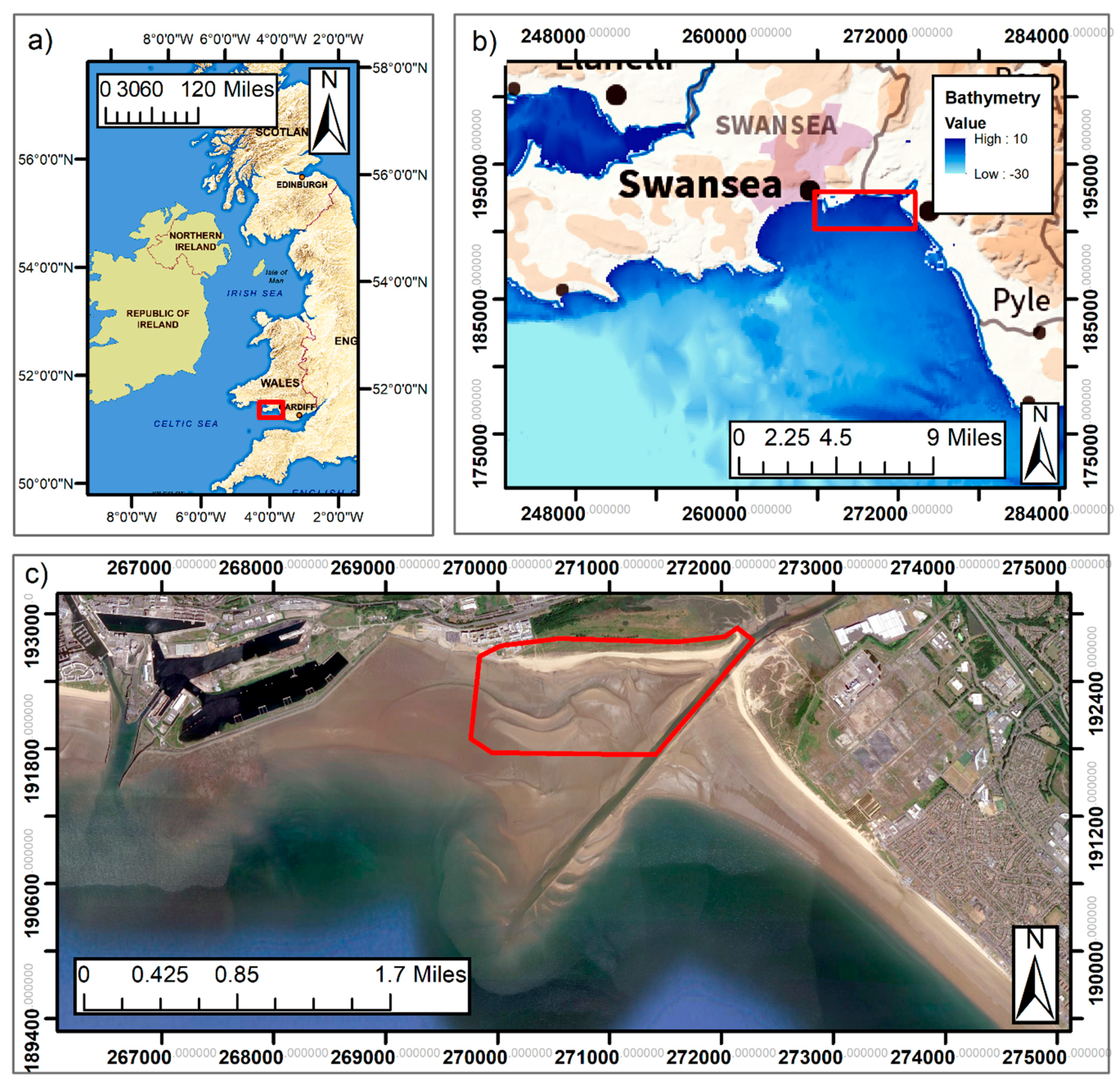
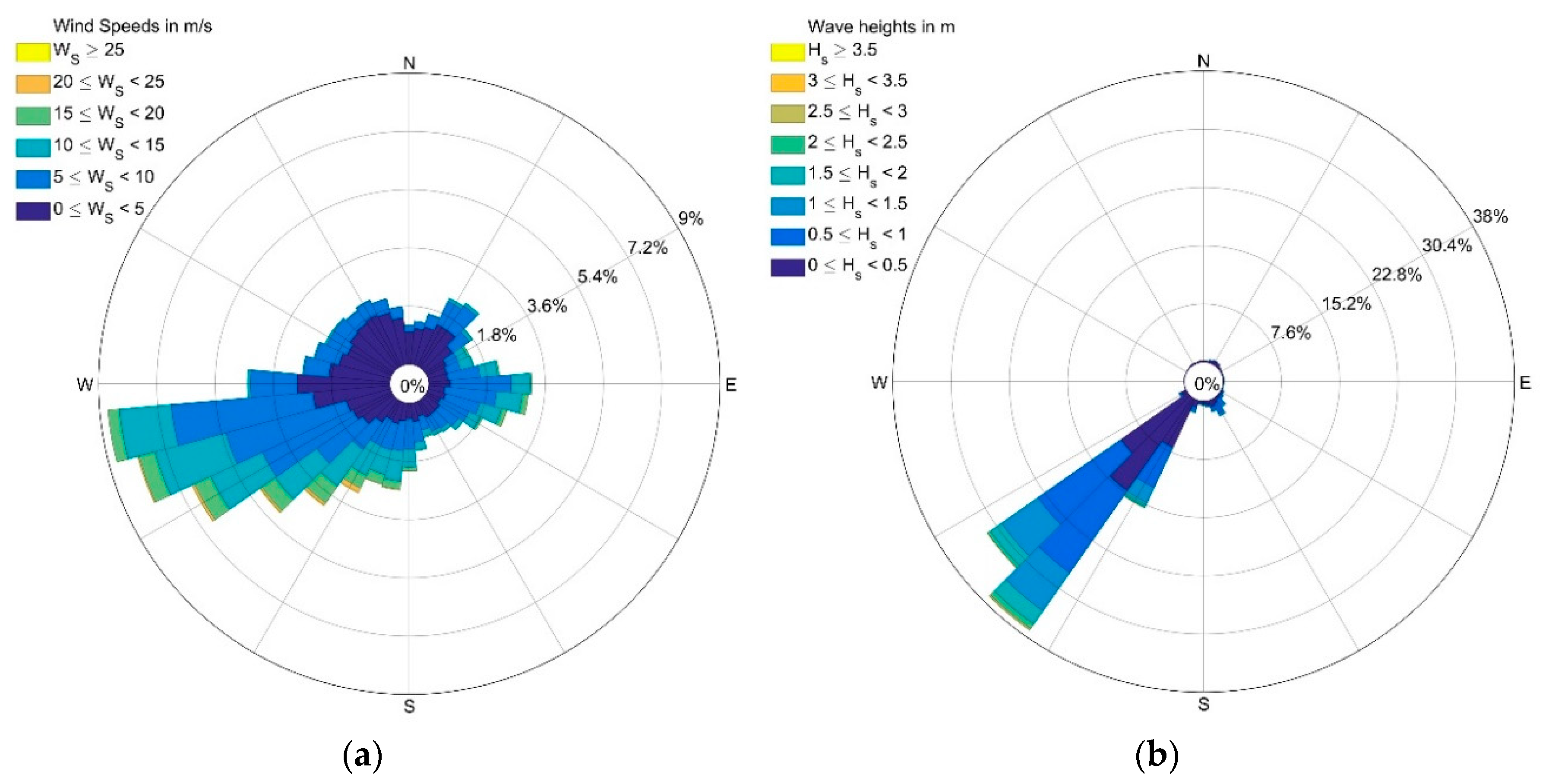

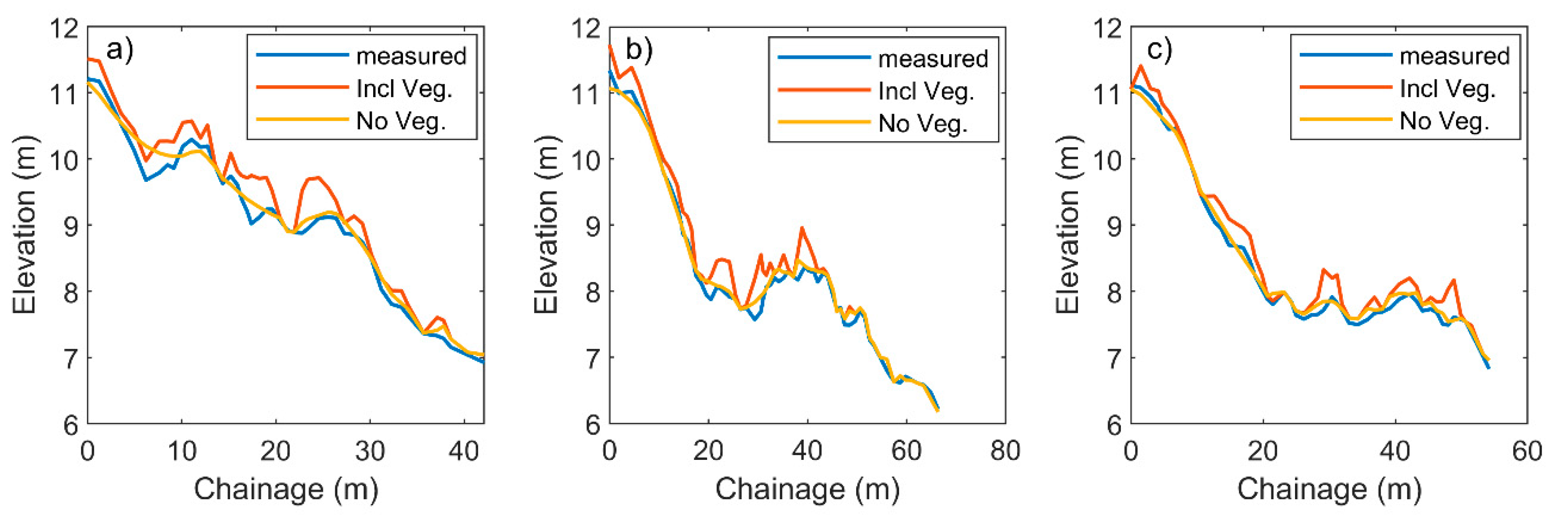
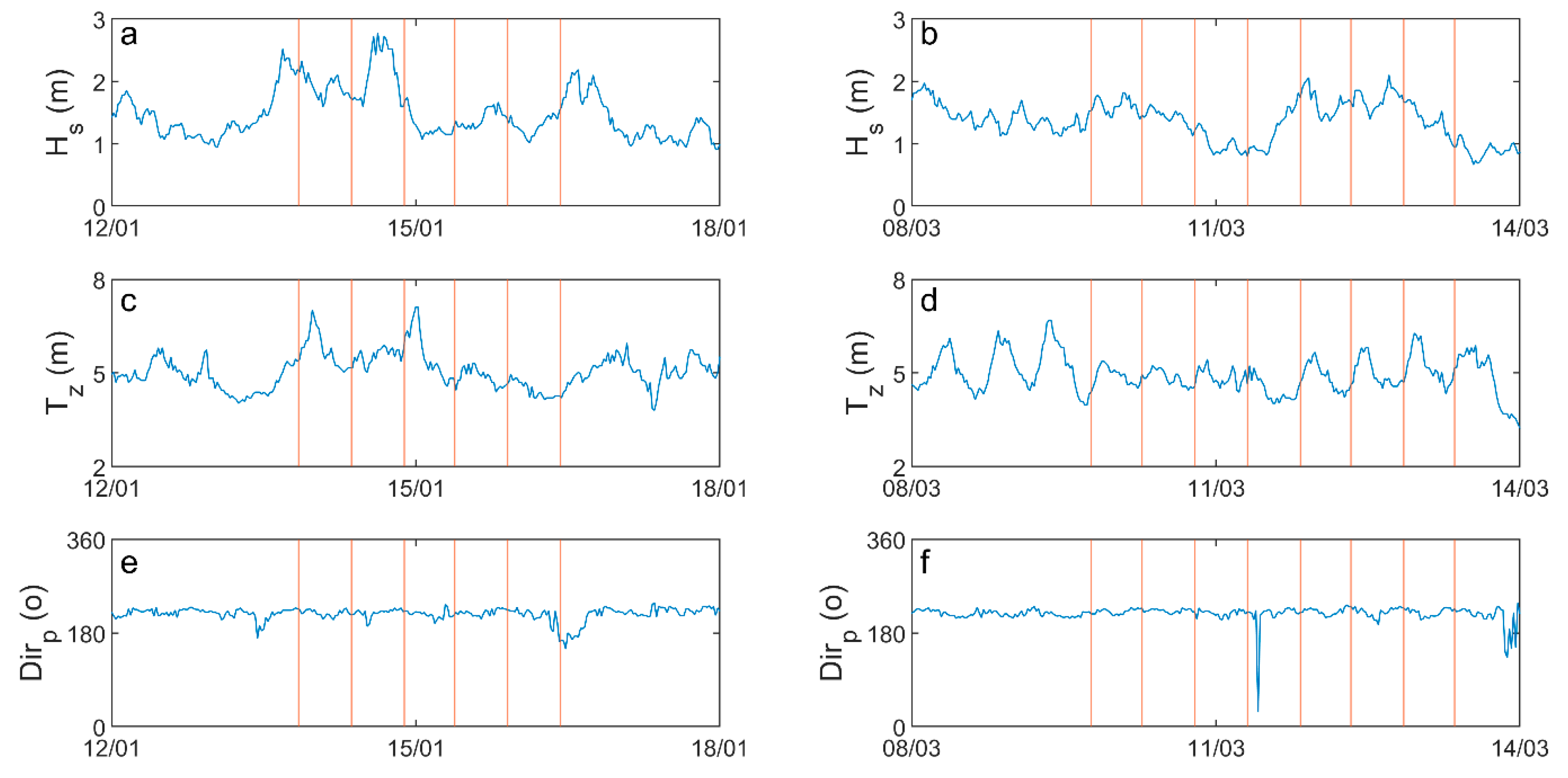






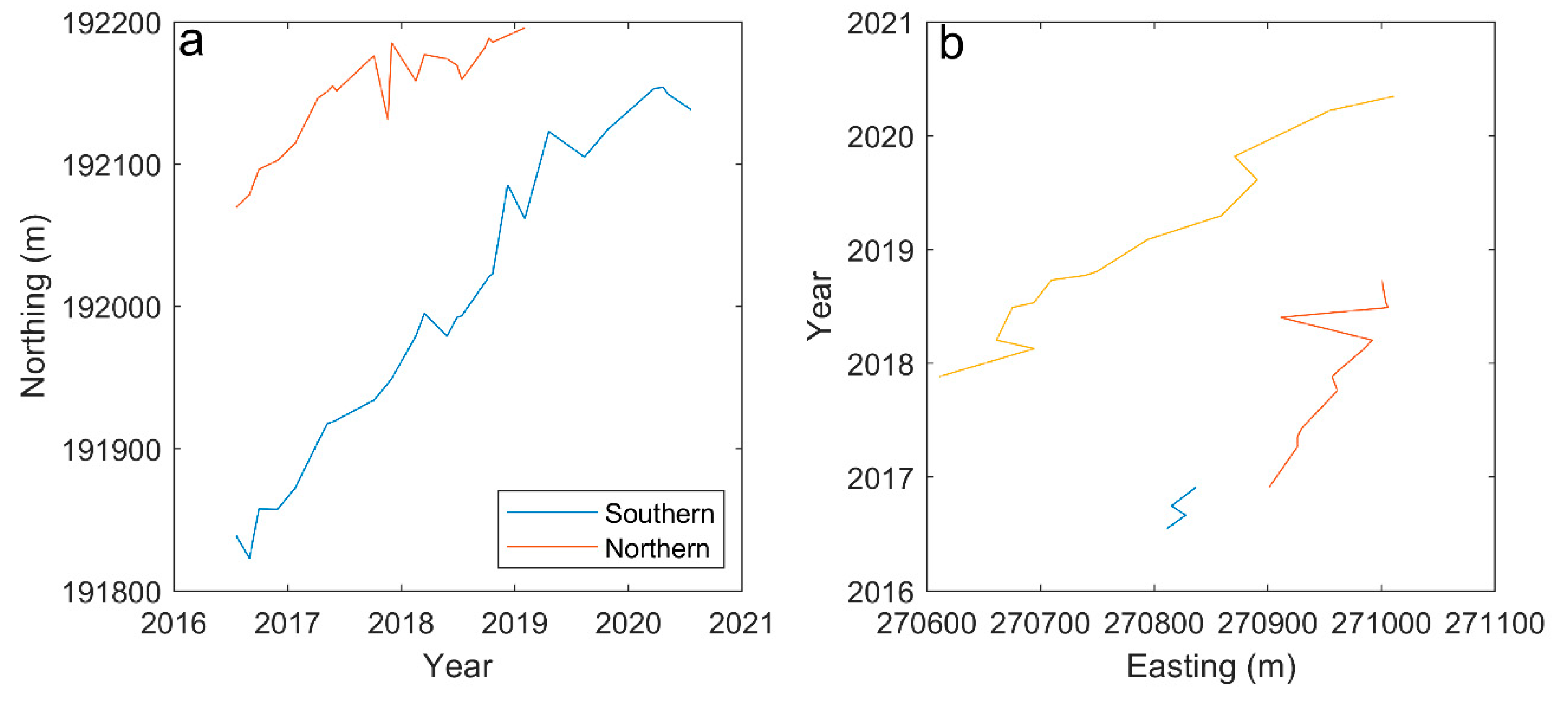
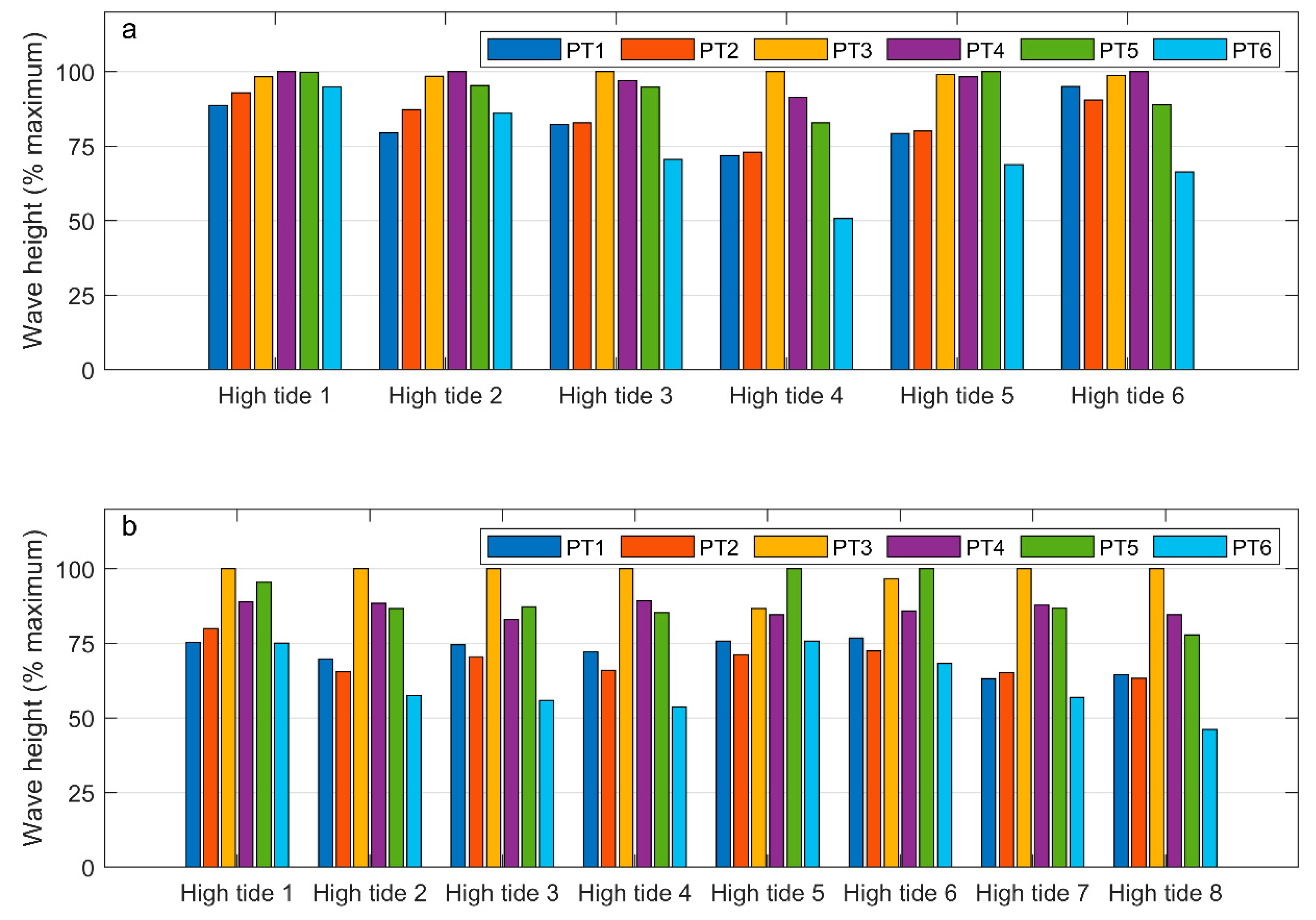

| Point Set | 4 GCP | 6 GCP | 8 GCP | 10 GCP | 12 GCP | 14 GCP | 16 GCP |
|---|---|---|---|---|---|---|---|
| MAE (m) | 0.054 | 0.057 | 0.052 | 0.057 | 0.051 | 0.050 | 0.056 |
| Point Set | Transect 1 | Transect 2 | Transect 3 |
|---|---|---|---|
| Including vegetation | 0.278 | 0.206 | 0.193 |
| Vegetation removed | 0.108 | 0.078 | 0.074 |
| Tide Number | PT1 | PT2 | PT3 | PT4 | PT5 | PT6 |
|---|---|---|---|---|---|---|
| 1 | 0.17 | 0.11 | 0.030 | 0 | 0 | 0.08 |
| 2 | 0.29 | 0.18 | 0.02 | 0 | 0.07 | 0.20 |
| 3 | 0.25 | 0.24 | 0 | 0.04 | 0.07 | 0.41 |
| 4 | 0.33 | 0.31 | 0 | 0.10 | 0.20 | 0.57 |
| 5 | 0.2 | 0.21 | 0.01 | 0.02 | 0 | 0.32 |
| 6 | 0.05 | 0.10 | 0.01 | 0 | 0.12 | 0.35 |
| Tide Number | PT1 | PT2 | PT3 | PT4 | PT5 | PT6 |
|---|---|---|---|---|---|---|
| 1 | 0.31 | 0.26 | 0 | 0.14 | 0.06 | 0.32 |
| 2 | 0.40 | 0.45 | 0 | 0.15 | 0.17 | 0.56 |
| 3 | 0.26 | 0.30 | 0 | 0.170 | 0.13 | 0.45 |
| 4 | 0.23 | 0.28 | 0 | 0.09 | 0.12 | 0.37 |
| 5 | 0.37 | 0.44 | 0.20 | 0.24 | 0 | 0.37 |
| 6 | 0.30 | 0.36 | 0.04 | 0.18 | 0 | 0.41 |
| 7 | 0.56 | 0.53 | 0 | 0.18 | 0.20 | 0.65 |
| 8 | 0.36 | 0.37 | 0 | 0.15 | 0.22 | 0.54 |
| Deployment | PT1 | PT2 | PT3 | PT4 | PT5 | PT6 | |
|---|---|---|---|---|---|---|---|
| 1 | Mean | 0.95 | 1.00 | 1.12 | 1.08 | 1.02 | 0.95 |
| Std. Dev. | 0.14 | 0.14 | 0.14 | 0.22 | 0.13 | 0.08 | |
| 2 | Mean | 1.20 | 1.16 | 1.33 | 1.20 | 1.42 | 1.20 |
| Std. Dev. | 0.18 | 0.12 | 0.15 | 0.09 | 0.17 | 0.23 |
Publisher’s Note: MDPI stays neutral with regard to jurisdictional claims in published maps and institutional affiliations. |
© 2020 by the authors. Licensee MDPI, Basel, Switzerland. This article is an open access article distributed under the terms and conditions of the Creative Commons Attribution (CC BY) license (http://creativecommons.org/licenses/by/4.0/).
Share and Cite
Fairley, I.; Horrillo-Caraballo, J.; Masters, I.; Karunarathna, H.; Reeve, D.E. Spatial Variation in Coastal Dune Evolution in a High Tidal Range Environment. Remote Sens. 2020, 12, 3689. https://doi.org/10.3390/rs12223689
Fairley I, Horrillo-Caraballo J, Masters I, Karunarathna H, Reeve DE. Spatial Variation in Coastal Dune Evolution in a High Tidal Range Environment. Remote Sensing. 2020; 12(22):3689. https://doi.org/10.3390/rs12223689
Chicago/Turabian StyleFairley, Iain, Jose Horrillo-Caraballo, Ian Masters, Harshinie Karunarathna, and Dominic E. Reeve. 2020. "Spatial Variation in Coastal Dune Evolution in a High Tidal Range Environment" Remote Sensing 12, no. 22: 3689. https://doi.org/10.3390/rs12223689
APA StyleFairley, I., Horrillo-Caraballo, J., Masters, I., Karunarathna, H., & Reeve, D. E. (2020). Spatial Variation in Coastal Dune Evolution in a High Tidal Range Environment. Remote Sensing, 12(22), 3689. https://doi.org/10.3390/rs12223689






